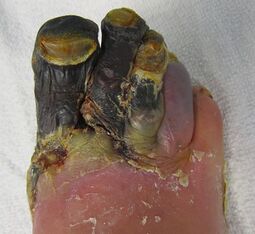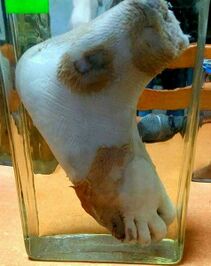Gangrene
This article is currently under review and may not be up to date. Please come back soon to see the finished work!
Introduction[edit | edit source]
Gangrene is the death of body tissues due to the loss of blood. It can be caused by illness, injury, or infection and usually happens in extremities like fingers, toes, and limbs. Gangrene can also occur in your organs and muscles [1].
Symptoms[edit | edit source]
Signs and symptoms of gangrene may include the following: [2]
- Skin discoloration which can be from pale to blue, purple, black, bronze or red, depending on the type of gangrene you have
- Swelling
- Blisters
- Sudden, severe pain followed by a feeling of numbness
- A foul-smelling discharge leaking from a sore
- Thin, shiny skin, or skin without hair
- Fever and feeling unwell depending on the type of gangrene
A few symptoms can be red flags and start before gangrene starts:
- Rest pain
- Pallor of extremities on elevation
- Poor capillary filling
- Thickening or scaling of the skin
Types of Gangrene[edit | edit source]
There are two main types of Gangrene:
1. Dry Gangrene
Dry gangrene is frequently observed among patients who have vascular disease, diabetes, and autoimmune diseases. It usually affects the hands and feet and happens when there is poor blood circulation to a certain area. Therefore, the tissue that dries up changes color and can either turn brown, purplish-blue, or black before the tissue can fall off. There is no infection associated with dry gangrene, but it can lead to wet gangrene if infected. Dry gangrene has a slow progression.
2. Wet Gangrene
Wet gangrene is a condition that involves infection and affects moist tissues such as respiratory tissues, oral tissues, cervix, and vulva. Swelling and blistering of the tissue are observed. An infection from wet gangrene can rapidly spread swift around the body[1]. For a patient with a history of foot ulcer or tissue injury post diabetes or ischemia, the presence of drainage and edema should be a red flag for a wet gangrene diagnosis. Moreover, a thorough evaluation of the foot is needed to rule out any presence of deep foot abscess that comes with a plantar tenderness [3]. Wet gangrene can progress from dry gangrene as the necrotic tissue becomes infected. In this case, it is therefore accompanied by an edematous and erythematous tissue surrounding the necrotic area [4].
The different types of Wet gangrene include:
- Internal gangrene affects internal organs such as the appendix or colon most of the time.
- Gas gangrene is a rare, dangerous, and life-threatening infection and is characterized by the presence of gas. If left untreated, gas gangrene can cause death within 48hrs [2].
- Fournier's gangrene is also a rare condition caused by an infection of the genital area. When the infection gets into the bloodstream, it is referred to as sepsis and is life-threatening. This type of gangrene affects more often men than women.
- Meleney's gangrene usually causes painful lesions on the skin one or two weeks post-surgery or minor trauma.
Risk Factors[edit | edit source]
There are conditions that affect the blood flow supply and therefore increase the risk of getting gangrene. They include: [2], [5]
- Diabetes
- Arteriosclerosis
- Severe injury or surgery
- High cholesterol
- Smoking
- Obesity
- Weakened immune system
- Injected medications or drugs
- Raynaud's Phenomenon
- Complications of COVID-19
Diagnosis[edit | edit source]
The diagnosis of gangrene is primarily clinical symptoms, with the medical history of the patient taken and physical examination done. Moreover, further tests can be done to confirm the diagnosis. These are:[5], [6]
- Blood Tests to look for bacteria or signs of infection.
- Imaging Tests such as MRI to specify the range of infection and CT scan offers a greater specificity for evaluating the extent of the disease to rule out any gas build up in the tissues.
- Angiography is a radiological test done to see the extent of ongoing or potential blood loss to tissue.
- Cultures to look for signs of bacteria or tissue death through a sample of fluid, blood or tissue. They help determine the appropriate antibiotic therapy to be given.
Treatment[edit | edit source]
Although the treatment of gangrene depends on its type, they all share the same general treatment goals which involve removal and treatment of dead tissue while focusing also on stopping the spread of infection and treating its cause.
The treatment of gangrene include: [1]
- Antibiotics to treat or prevent infection
- Oxygen Therapy is used to treat Wet gangrene but can also be used to slow growth of bacteria
- Surgery or debridement to remove dead tissue and avoid the spreading of the infection
Complications[edit | edit source]
References[edit | edit source]
- ↑ 1.0 1.1 1.2 Gangrene. Available from: https://www.webmd.com/skin-problems-and-treatments/guide/gangrene-causes-symptoms-treatments ( Accessed, 11/09/2021).
- ↑ 2.0 2.1 2.2 Gangrene. Available from: https://www.mayoclinic.org/diseases-conditions/gangrene/symptoms-causes/syc-20352567 (Accessed, 13/09/2021).
- ↑ Buttolph A, Sapra A. Gangrene. StatPearls [Internet]. 2021 Aug 11.
- ↑ Mahmood, Ahmed Hussein. (2021). Wet Gangrene.
- ↑ 5.0 5.1 Gangrene. Available from: https://www.medicinenet.com/gangrene/article.htm (Accessed, 04/10/2021).
- ↑ Chennamsetty A, Khourdaji I, Burks F, Killinger KA. Contemporary diagnosis and management of Fournier’s gangrene. Therapeutic advances in urology. 2015 Aug;7(4):203-15.








